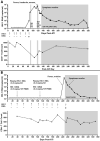Antiretroviral-free HIV-1 remission and viral rebound after allogeneic stem cell transplantation: report of 2 cases
- PMID: 25047577
- PMCID: PMC4236912
- DOI: 10.7326/M14-1027
Antiretroviral-free HIV-1 remission and viral rebound after allogeneic stem cell transplantation: report of 2 cases
Abstract
Background: It is unknown whether the reduction in HIV-1 reservoirs seen after allogeneic hematopoietic stem cell transplantation (HSCT) with susceptible donor cells is sufficient to achieve sustained HIV-1 remission.
Objective: To characterize HIV-1 reservoirs in blood and tissues and perform analytic antiretroviral treatment interruptions to determine the potential for allogeneic HSCT to lead to sustained, antiretroviral-free HIV-1 remission.
Design: Case report with characterization of HIV-1 reservoirs and immunity before and after antiretroviral interruption.
Setting: Tertiary care center.
Patients: Two men with HIV with undetectable HIV-1 after allogeneic HSCT for hematologic tumors.
Measurements: Quantification of HIV-1 in various tissues after HSCT and the duration of antiretroviral-free HIV-1 remission after treatment interruption.
Results: No HIV-1 was detected from peripheral blood or rectal mucosa before analytic treatment interruption. Plasma HIV-1 RNA and cell-associated HIV-1 DNA remained undetectable until 12 and 32 weeks after antiretroviral cessation. Both patients experienced rebound viremia within 2 weeks of the most recent negative viral load measurement and developed symptoms consistent with the acute retroviral syndrome. One patient developed new efavirenz resistance after reinitiation of antiretroviral therapy. Reinitiation of active therapy led to viral decay and resolution of symptoms in both patients.
Limitation: The study involved only 2 patients.
Conclusion: Allogeneic HSCT may lead to loss of detectable HIV-1 from blood and gut tissue and variable periods of antiretroviral-free HIV-1 remission, but viral rebound can occur despite a minimum 3-log10 reduction in reservoir size. Long-lived tissue reservoirs may have contributed to viral persistence. The definition of the nature and half-life of such reservoirs is essential to achieve durable antiretroviral-free HIV-1 remission.
Primary funding source: Foundation for AIDS Research and National Institute of Allergy and Infectious Diseases.
Conflict of interest statement
Figures


Comment in
-
Finding a cure for HIV: much work to do.Ann Intern Med. 2014 Sep 2;161(5):368-9. doi: 10.7326/M14-1573. Ann Intern Med. 2014. PMID: 25047731 No abstract available.
Similar articles
-
Mechanisms That Contribute to a Profound Reduction of the HIV-1 Reservoir After Allogeneic Stem Cell Transplant.Ann Intern Med. 2018 Nov 20;169(10):674-683. doi: 10.7326/M18-0759. Epub 2018 Oct 16. Ann Intern Med. 2018. PMID: 30326031
-
Impact of Allogeneic Hematopoietic Stem Cell Transplantation on the HIV Reservoir and Immune Response in 3 HIV-Infected Individuals.J Acquir Immune Defic Syndr. 2017 Jul 1;75(3):328-337. doi: 10.1097/QAI.0000000000001381. J Acquir Immune Defic Syndr. 2017. PMID: 28350553 Free PMC article.
-
Multiple measures of HIV burden in blood and tissue are correlated with each other but not with clinical parameters in aviremic subjects.AIDS. 2003 Jan 3;17(1):53-63. doi: 10.1097/00002030-200301030-00008. AIDS. 2003. PMID: 12478069
-
From Berlin to London: HIV-1 Reservoir Reduction Following Stem Cell Transplantation.Curr HIV/AIDS Rep. 2020 Aug;17(4):385-393. doi: 10.1007/s11904-020-00505-2. Curr HIV/AIDS Rep. 2020. PMID: 32519184 Review.
-
Single-molecule techniques to quantify and genetically characterise persistent HIV.Retrovirology. 2018 Jan 9;15(1):3. doi: 10.1186/s12977-017-0386-x. Retrovirology. 2018. PMID: 29316955 Free PMC article. Review.
Cited by
-
Advancing towards HIV-1 remission: Insights and innovations in stem cell therapies.Arch Stem Cell Ther. 2024;5(1):5-13. doi: 10.46439/stemcell.5.020. Arch Stem Cell Ther. 2024. PMID: 39301092 Free PMC article.
-
HIV Reactivation from Latency after Treatment Interruption Occurs on Average Every 5-8 Days--Implications for HIV Remission.PLoS Pathog. 2015 Jul 2;11(7):e1005000. doi: 10.1371/journal.ppat.1005000. eCollection 2015 Jul. PLoS Pathog. 2015. PMID: 26133551 Free PMC article.
-
Haemopoietic cell transplantation in patients living with HIV.Lancet HIV. 2020 Sep;7(9):e652-e660. doi: 10.1016/S2352-3018(20)30117-X. Epub 2020 Aug 10. Lancet HIV. 2020. PMID: 32791046 Free PMC article. Review.
-
CROI 2016: Basic Science Review.Top Antivir Med. 2016 May-Jun;24(1):4-9. Top Antivir Med. 2016. PMID: 27398858 Free PMC article. Review.
-
Real-Time Predictions of Reservoir Size and Rebound Time during Antiretroviral Therapy Interruption Trials for HIV.PLoS Pathog. 2016 Apr 27;12(4):e1005535. doi: 10.1371/journal.ppat.1005535. eCollection 2016 Apr. PLoS Pathog. 2016. PMID: 27119536 Free PMC article.
References
Publication types
MeSH terms
Substances
Grants and funding
LinkOut - more resources
Full Text Sources
Other Literature Sources
Medical
